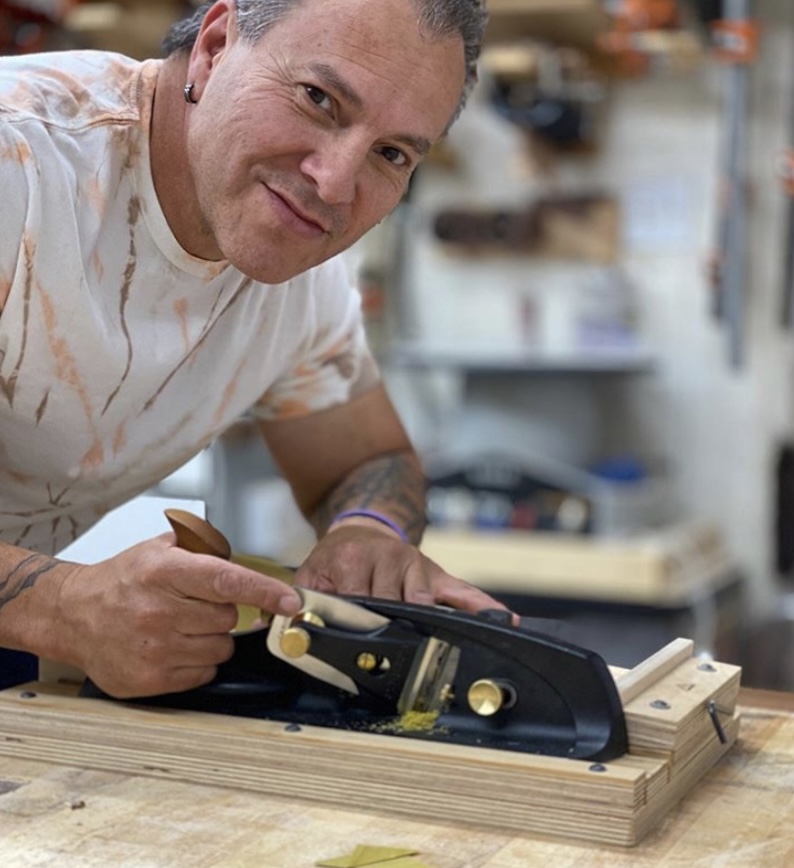Furniture Care
“Quality, hand-made furniture is beautiful and durable. Caring for these future antiques today is an essential part in making tomorrow’s heirloom.”
Ramon Valdez
Quality Furniture Checklist
Many furniture stores will sell their furniture as “all wood” construction. That does not necessarily mean that it is fabricated completely of solid wood…..usually, the piece will contain either composite (particle board) and/or plywood. “Solid wood” construction means that all exposed parts are genuine hardwood lumber. Large panels will be constructed by gluing boards with glue that is stronger than the wood itself. To check for this type of construction, look at a seam and follow it to the back or underside. If you cannot follow the line or seam, then it probably is not solid wood. Quality composite boards or medium density fiberboard (MDF) bonded with solid hardwood veneer on the surface is sometimes referred to as “all wood” construction. This is not necessarily an inferior product. MDF with veneer will not move, twist or warp under humidity changes like solid wood construction may do. However, the term “veneer” is used many times to sell “furniture” that is actually artificial laminate surfaces of plastic, foil or paper. In this instance, “veneer” is a photographic image of wood grain patterns that are then bonded to particle board. This is not traditional veneer! Also, the terms “oak, maple or cherry finish” may refer to the color or photographic image used to replicate the woods’ grain and does not mean that it is genuine solid hardwood.
For furniture that will last generations, it must be constructed properly and with quality joinery! Here are some tell-tale signs to look for when shopping for future heirlooms:
Finishes
A quality finish should be consistent from one side of the piece to the other. In other words, the sheen should be the same on the whole piece, whether it is a satin or a high gloss. It should be smooth and free of runs, drips and bubbles. Check corners for excessive finish material.
Drawer Boxes
Drawers should be inspected inside, outside and underneath. Look for solid wood construction of the sides and back, as well as quality joinery like dovetails or box joints. Check to make sure drawers slide easily without binding and that hardware (handles, knobs or pulls) are installed straight.
Joinery
Quality joinery is one of the most important factors when shopping for furniture that is going to last a lifetime. Always look for joints like dovetails, box joints, mortise and tenon, and miters that are reinforced with splines, etc. Avoid furniture that is assembled with a lot of mechanical fasteners like screws, staples and nails. Often times, fine, high-end pieces of furniture will not have these because the craftsman who made the piece relies on quality joinery that will certainly hold a piece together for generations.
Overall Construction
One should always check for the obvious, like the overall appearance. How sturdy a piece is will depend on many factors. A table for instance should be rigid and stable. If a chair is too fragile to sit in, is it really a chair?
Ramon Valdez
Hardwoods and Softwoods
The term “hardwoods” and “softwoods” can sometimes be misleading. Some softwoods are physically heavier and harder than some hardwoods. Douglas-fir, for example, one of the world’s most plentiful species of softwood, is actually almost four times as dense as Balsa, the world’s softest and lightest commercially imported hardwood. The term softwood is used to designate woods produced by gymnosperm species, primarily needle-bearing conifers, (from the Latin word meaning “cone-bearing”), such as pine, spruce, redwood and fir. The hardwoods, or angiosperms, are represented by broad-leafed flowering trees, such as maple, oak, and cherry.
Ramon Valdez
How to Make an Heirloom
Quality, hand-made furniture is beautiful and durable. Caring for these future antiques today is an essential part in making tomorrow’s heirloom. Here are some tips to do just that:
Avoid placing furniture in direct sunlight. Adjust window shades, if needed, to prevent this.
Avoid placing furniture in front of fireplaces, close to wood stoves or over heater-vents.
Objects placed on top of furniture should have felt pads on the bottom to prevent the finish from being scratched. Coasters should also have felt on their underside.
Products containing solvents (fingernail polish and polish remover, lighter fluid, alcohol, car polishes and cleaners) should be kept away from wood furniture.
Always follow manufacturer’s instructions for care and cleaning.
Ramon Valdez
A Care Guide for Solid Hardwood Furniture
Since finishes can vary greatly, one should always check with the manufacturer before trying any remedy! · Dusting often helps remove abrasive particles. · Dust furniture lightly with a soft cloth (cotton baby diapers or old t-shirts work well) going with the grain. If needed, you can use a mild, non-alkaline soap. Use a soft cloth moistened with the suds to gently clean mild stains or fingerprints. Always remember to check the finish in an inconspicuous area when using this type of cleaning. Dry immediately with a clean, soft cloth.
Ramon Valdez
Remedies for Solid Hardwood Furniture
Let’s face it, accidents happen! A scratch, dent, watermark left by a glass, or a multitude of other incidents can happen when we least expect it. Most common stains can be removed (at least made inconspicuous) with simple techniques. Be sure to test on a small area first to ensure that the finish will not be damaged.
Rings or Watermarks
Rings are left behind from condensation and in many cases are just in the wax and not in the finish. Cover the mark with a clean cloth and press down with an iron that is warm to the touch. You can also try rubbing the stain with mayonnaise, salad oil or olive oil. Wipe dry with a clean, dry, soft cloth.
Tape or Sticky Residue
Dampen the area thoroughly with olive oil (or salad oil) for several minutes and then rub lightly with steel wool (extra fine or 0000). Make sure and rub in straight lines and with the grain. Wipe dry with a clean, dry, soft cloth.
Cigarette Burns
Some burns can be removed by rubbing the area with a quality polish like Old English, with a stain close to the finish. Or try buffing out the burn with a combination of mineral oil (or linseed oil) and rottenstone. Again, work with the grain until the burn is removed. Wipe dry with a clean, dry, soft cloth.
Paint Splatters
Splatters and drips can be removed (if fresh) by wiping immediately with a dampened rag. Use water if paint is latex based and mineral spirits (paint thinner) if oil based. If paint has already dried, try soaking paint spot in boiled linseed oil until paint softens, then carefully lift with a plastic putty knife. Use a mixture of rottenstone and boiled linseed oil to remove any residue left behind. Wipe dry with a clean, dry, soft cloth.
Candlewax or Gum
Begin by hardening the wax or gum with an ice cube wrapped in a soft cloth, approximately 5 minutes. Gently pry off with a plastic putty knife. Buff out area with extra-fine (0000) steel wool and mineral spirits. Wipe dry with a clean, dry, soft cloth.
Crayon
Gently rub the marks with extra-fine steel wool soaked in mineral spirits. Blend in surrounding area. Wipe dry with a clean, dry, soft cloth.
Fingernail Polish
Blot spill immediately and then gently rub area with extra-fine steel wool dipped in mineral spirits.
Message Ramon
Get In touch. Ask Any Question or Start a Free Quote

